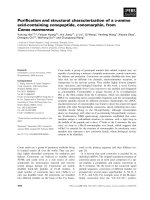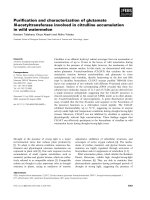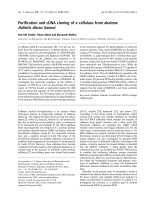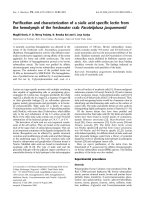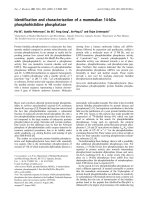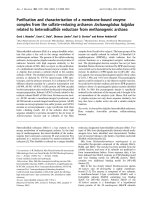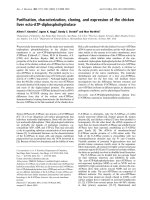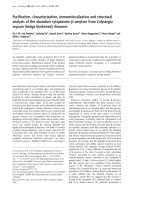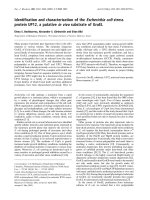Báo cáo Y học: Purification and characterization of novel kininogens from spotted wolffish and Atlantic cod pdf
Bạn đang xem bản rút gọn của tài liệu. Xem và tải ngay bản đầy đủ của tài liệu tại đây (386.11 KB, 8 trang )
Purification and characterization of novel kininogens from spotted
wolffish and Atlantic cod
Anne Ylo¨ nen
1
, Jari Helin
1
, Jarl Bøgwald
2
, Anu Jaakola
1
, Ari Rinne
3
and Nisse Kalkkinen
1
1
Institute of Biotechnology, Protein Chemistry Laboratory, University of Helsinki, Finland,
2
Norwegian College of Fishery Science,
University of Tromsø, Norway,
3
Institute of Medical Biology, University of Tromsø, Norway
Kininogens are multifunctional proteins found so far mainly
in mammals. They carry vasoactive kinins as well as parti-
cipate in defense, blood coagulation and the acute phase
response. In this study, novel kininogens were isolated from
Atlantic cod (Gadus morhua L.) and spotted wolffish
(Anarhichas minor) by papain-affinity chromatography. The
molecular mass of cod kininogen determined by MALDI-
TOF mass spectrometry to be 51.0 kDa and it had pI values
of 3.6, 3.9 and 4.4. The molecular mass of wolffish kininogen
was 45.8 kDa and it had pI values of 4.1, 4.3, 4.35 and 4.4.
Partial amino-acid sequences determined from both kinin-
ogens showed clear homology with previously determined
kininogen sequences. Both kininogens were found to inhibit
cysteine proteinases like papain and ficin but they had no
effect on trypsin, a serine proteinase. Wolffish kininogen
carried a2,3-sialylated biantennary and triantennary N-gly-
cans with extensive sialic acid O-acetylation. Cod kininogen
carried similar glycan structures but about 1/3 of its glycans
carried sulfate at their N-acetylglucosamine units.
Keywords: Atlantic cod; spotted wolffish; kininogen; N-gly-
cosylation; O-acetylation.
Kininogens are large molecular mass (50–114 kDa) cysteine
proteinase inhibitors belonging to class 3 of the cystatin
superfamily. They are single-chain proteins composed of an
N-terminal heavy chain, the bradykinin moiety and a
C-terminal light chain. The heavy chain and light chain are
interlinked by disulfide bridges. Kininogens are further
classified into high molecular mass and low molecular mass
kininogens bearing identical heavy chains but the length and
the amino-acid sequence of the light chain varies. A
vasoactive peptide, bradykinin, is released from kininogens
by kallikreins [1].
In addition to carrying bradykinin, kininogens have
many other biological functions. They participate in intrin-
sic blood coagulation and in acute phase reactions as well as
inhibit cysteine proteinases [2].
Kininogens have been characterized from many mam-
mals including human, bovine, rat [1], and recently whale
[3]. In addition, there are reports on bradykinins in fish
including steelhead trout [4] and Atlantic cod [5]. We have
recently isolated a kininogen and another high molecular
mass cysteine proteinase inhibitor from the skin of Atlantic
salmon [6]. To our knowledge, no other kininogen from fish
has been described so far.
Here, we describe the purification of kininogens from the
skin of spotted wolffish (Anarhichas minor)andAtlantic
cod (Gadus morhua L.). These novel kininogens were
characterized by determining their molecular mases, partial
amino-acid sequences, glycan structures, isoelectric points,
as well as their inhibitory activities.
MATERIALS AND METHODS
Fish skin samples
The starting material for the purifications were the skin of
spotted wolffish (Anarhichas minor) and Atlantic cod (Gadus
morhua L.) weighing 2–3 kg. The skin (1 kg) was homo-
genized in 1 L of 10 m
M
Tris/HCl pH 7.4, 10 m
M
EDTA,
0.25
M
sucrose, 0.1 m
M
phenylmethanesulfonyl fluoride,
5m
M
benzamidine and 15 m
M
sodium azide. The homo-
genate was centrifuged at 6000 g for 30 min at 4 °C, and the
supernatant was collected. To further clarify the superna-
tant, it was ultracentrifuged at 100 000 g for 2 h at 4 °C.
The clear extract was collected underneath the floating fat.
Purification and characterization of inhibitors
The inhibitors from skin extracts were purified as described
[6]. After ultracentrifugation the clarified skin extract was
subjected to papain-affinity chromatography, gel filtration,
anion-exchange chromatography and reversed-phase chro-
matography.
Mass spectrometry
Matrix-assisted laser desorption/ionization time-of-flight
(MALDI-TOF) mass spectrometry was performed on a
Biflex
TM
time-of-flight instrument (Bruker Daltonik,
Bremen, Germany) equipped with a nitrogen laser operating
at 337 nm. Proteins were analysed in sinapic acid (Fluka
Chemie AG, Buchs, Switzerland), as described previously
[6]. Glycans were analysed using 2,4,6-trihydroxyacetophe-
none (Fluka) or 2,5-dihydroxybenzoic acid (Aldrich,
Correspondence to A.Ylo
¨
nen, Protein Chemistry Laboratory,
Institute of Biotechnology, PO Box 56 (Viikinkaari 9), FIN-00014
University of Helsinki, Finland.
Fax: + 358 9191 59416, Tel.: + 358 9191 59414,
E-mail: anne.ylonen@helsinki.fi
Enzymes: papain (EC 3.4.22.2); ficin (EC 3.4.22.3); trypsin
(EC 3.4.21.4); glutamyl endopeptidase GluC (EC 3.4.21.19).
(Received 5 December 2001, revised 2 April 2002, accepted
10 April 2002)
Eur. J. Biochem. 269, 2639–2646 (2002) Ó FEBS 2002 doi:10.1046/j.1432-1033.2002.02927.x
Steinheim, Germany) as the matrix as described previously
[7]. Peptides were analysed using a-cyano-4-hydroxycin-
namic acid matrix (Aldrich) as described previously [7].
Capillary isoelectric focusing
Capillary isoelectric focusing was performed by using a
BioFocusÒ 3000 Capillary Electrophoresis System (Bio-
Rad, Richmond, CA, USA). Focusing was performed in
Bio-Lyte Ampholyte (pH 3–10, Bio-Rad), in an eCAPÒ
neutral capillary (50 lm · 50 cm, Beckman Instruments,
Fullerton, CA, USA) according to the manufacturer’s
instructions. BioMarkÒ CIEF markers (pI values 5.3, 6.4,
7.4, 8.4 and 10.4, Bio-Rad) were used for internal calibra-
tion.
SDS/PAGE and electroblotting
The proteins were separated by SDS/PAGE in a 12%
polyacrylamide (w/v) gel [8] and stained with silver [9]. For
N-terminal sequencing, the SDS/PAGE separated proteins
were subjected to electroblotting on a poly(vinylidene
difluoride) membrane (ProBlottÒ, PerkinElmer, Applied
Biosystems, CA, USA) in 10 m
M
3-(cyclohexylamino)pro-
pane-1-sulfonic acid (pH 11)/10% (v/v) methanol with a
constant potential of 50 V for 120 min [10]. After staining
with Coomassie Brilliant Blue (0.1% in 1% acetic acid/40%
methanol) and destaining (50% methanol) the protein
bands were cut out and loaded on the sequencer.
Alkylation, enzymatic digestion and peptide separation
For in-gel digestion, the proteins were separated by SDS/
PAGE and stained with Coomassie Brilliant Blue (0.1% in
0.5% acetic acid/30% methanol) and destained (30%
methanol). The excised protein bands were alkylated with
iodoacetamide and digested with trypsin as described
previously [11]. For in-solution digestion, the purified
proteins from reversed-phase chromatography were alkyl-
ated with 4-vinylpyridine and enzymatically digested with
trypsin [6] or endoproteinase GluC. For endoproteinase,
GluC digestion a 30-lg sample of alkylated protein was
dissolved in 50 lLof50m
M
ammonium acetate, pH 4.3
anddigestedwith0.5lg of endoproteinase GluC by
incubation at 37 °C overnight. Generated peptides were
separated by reversed-phase chromatography.
Sequence analysis
Protein N-terminal sequencing and internal peptide sequen-
cing were performed with a Procise 494A sequencer
(PerkinElmer Applied Biosystems Division).
Inhibition assay
After each chromatographic step the inhibitory activity of
collected fractions was determined using papain as the
enzyme in the assay [6]. The same assay was used to
determine inhibitory activites of purified proteins against
papain, ficin and trypsin with BANA (N
a
-benzoyl-
DL
-
arginine-2-naphtylamide, Fluka Chemie AG) as a substrate.
Positive controls were leupeptin for papain and ficin and
phenylmethanesulfonylfluoride for trypsin.
Glycan isolation
Samples ( 30 lg) of wolffish kininogen and cod kininogen
were subjected to enzymatic N-glycan removal with
N-glycosidase F. The dry protein sample was dissolved in
100 lLof20m
M
sodium phosphate buffer containing
0.1% SDS and 1% b-octylglucoside, and 2 U of
N-glycosidase-F (Roche Biochemicals, Switzerland) were
added. After 48 h incubation at 37 °C, the reaction mixture
was diluted with 4 vol. of water, and the de-N-glycosylated
protein was adsorbed to poly(vinylidene difluoride) mem-
brane by centrifugation in a ProSpin
TM
sample preparation
cartridge (PerkinElmer Applied Biosystems Division). The
N-glycans were collected from the poly(vinylidene difluo-
ride) flow-through, and were further purified by passing
through a BondElut C18 extraction cartridge (Varian SPP,
Harbor City, CA, USA) and by gel filtration chromato-
graphy as described previously [12]. No separation of the
individual N-glycan components was attempted prior to
mass spectrometric analyses.
The poly(vinylidene difluoride) membrane carrying the
de-N-glycosylated protein was subjected to b-elimination to
liberate potential O-glycosidically linked glycans. The
membrane was incubated in 150 lLof1
M
NaBH
4
in
0.1
M
NaOH for 48 h at 37 °C, and the liberated oligosac-
charide alditols were recovered as described previously [12].
O-Glycan fractions were subjected to permethylation [13]
prior to MALDI-TOF MS analysis.
Removal of O-acetyl groups
The isolated N-glycans were saponified as described previ-
ously [14].
Glycosidase digestions
Digestions with Newcastle disease virus (NDV) neuramini-
dase and Streptococcus pneumoniae b1,4-galactosidase
(Oxford Glycosciences, Abingdon, UK) were carried out
as described previously [14]. Digestion with jack bean
b-galactosidase (Glyko, Novato, CA, USA) was carried out
in 10 lLof100m
M
sodium citrate, pH 4.5, at 37 °C. An
aliquot of 1.5 lL was removed after 16 h of digestion, drop-
dialysed against water and analysed by MALDI-TOF MS.
Phosphatase treatment
Dry N-glycan samples were dissolved in 50 m
M
ammonium
bicarbonate, and 1 U of calf intestinal alkaline phosphatase
(New England Biolabs, Beverly, MA, USA) was added.
Synthetic phosphorylated peptides were used as positive
controls. After a 2-h incubation at 37 °C. the solution was
passed through a POROS R3 (PerSeptive Biosystems,
Framingham MA, USA) tip, and a sample of the flow-
through carrying the glycans was drop-dialysed and
analysed by MALDI-TOF MS.
RESULTS
Isolation of cysteine proteinase inhibitors
The first step in cysteine proteinase inhibitor isolation from
the cod skin extract was affinity chromatography on
2640 A. Ylo
¨
nen et al. (Eur. J. Biochem. 269) Ó FEBS 2002
immobilized papain. Cysteine proteinase inhibitors bound
into papain matrix were eluted and the fractions showing
over 70% inhibitory activity in the inhibition assay were
pooled, concentrated and further purified by gel filtration.
The fractions from gel filtration exhibiting inhibitory
activity were subjected to anion-exchange chromatography,
yielding a single major protein peak expressing inhibitory
activity. This fraction was further subjected to reversed-
phase chromatography and the protein obtained was
analysed by SDS/PAGE and MALDI-TOF spectrometry
(Fig. 1). In SDS/PAGE, the inhibitor from cod skin
migrated at a position corresponding to 78 kDa, whereas
MALDI-TOF mass spectrometry gave a molecular mass of
51.0 kDa. Apparently, the glycans on this inhibitor result in
the slower migration in SDS/PAGE than expected. Some
purified cod inhibitor samples carried also a very faint
60-kDa band as analysed by SDS/PAGE. The relationship
between the major 78 kDa and minor 60 kDa gel bands
were investigated by in-gel digestion and peptide mass
fingerprinting. All peptide signals present in the MALDI-
TOF mass maps from the 60 kDa band were also present in
the mass map from the 78-kDa band, suggesting that the
60-kDa band represents a fragment of the 78-kDa band.
Similar related forms were detected also in salmon kinino-
gen [6].
In the tryptic mass map, we also detected peptide masses
which were tentatively identified as fish bradykinin (m/z
1065.59) peptide as well as fish Arg-bradykinin (m/z
1221.72), previously detected also from salmon kininogen
tryptic digest. These results were verified by peptide
sequencing [RPPGWSPLR and RRPPGWSPLR
(Table 1)]. Accordingly, this cysteine proteinase inhibitor
was named cod kininogen. Several isoelectric forms (pI
values 3.6, 3.9 and 4.4) of this kininogen were detected by
capillary isoelectric focusing, which may be partly ascribed
to heterogeneous glycosylation. The yield of reversed-phase
purified cod kininogen from 200 mL of cod skin extract was
800 lg.
A cysteine proteinase inhibitor was isolated from
wolffish skin extract as above. The wolffish inhibitor
purified by reversed-phase chromatography still exhibited
two bands in SDS/PAGE, 67 and 42 kDa (Fig. 1). In
MALDI-TOF MS, this fraction only shows one clear
signal at 45.8 kDa (Fig. 1), probably representing the
67-kDa band that stains poorly in gels. Similar behaviour
was observed for salmon kininogen [6], and it is possible
that the poor staining may be partly the result of
extensive glycosylation. Both bands of the wolffish
inhibitor were investigated by in-gel digestion and mass
mapping. As above, the peptide patterns obtained were
similar, and both included signals appropriate for the fish
bradykinin and Arg-bradykinin sequences. Peptide
sequencing verified these observations and therefore the
cysteine proteinase inhibitor of wolffish skin was named
wolffish kininogen. Several forms of the protein with
different isoelectric points were again observed (pI values
4.1, 4.3, 4.35, 4.4). The yield of reversed phase purified
wolffish kininogen was 850 lg from 200 mL of skin
extract.
We have previously isolated two high molecular mass
cysteine proteinase inhibitors from the skin of Atlantic
salmon, a kininogen and a 42-kDa protein named salarin
[6]. An identical experimental approach was used in the
present study, but interestingly no salarin type inhibitor was
detected in the skin of wolffish or cod.
Inhibition studies
The inhibitory activity of cod and wolffish kininogen was
measured with samples purified by reversed phase chroma-
tography. Both kininogens were found to inhibit papain and
ficin (cysteine proteinases) but neither of them had any
effect on trypsin (a serine proteinase). Their specific activities
against papain were calculated from inhibition curves
(Fig. 2) and were found to be 940 UÆmg
)1
for cod kininogen
and 6200 UÆmg
)1
for wolffish kininogen (units are defined
Fig. 1. SDS/PAGE visualized by silver staining of purified cod kininogen and wolf fish kininogen, and MALDI-TOF mass spectra of kininogens
purified by reversed-phase chramotography.
Ó FEBS 2002 Novel kininogens from cod and wolffish (Eur. J. Biochem. 269) 2641
as lg of papain inhibited per mg of inhibitor, data not
shown). The inhibitory activity of cod kininogen and
wolffish kininogen has also been investigated with different
cathepsins isolated from cod, wolffish and salmon
(E. Weber, Institute of Physiological Chemistry, Martin-
Luther-University, Halle-Wittenberg, Germany, personal
communication). These experiments suggest that these
kininogens inhibit specifically cathepsin L but not cathepsin
B or cathepsin H.
Determination of partial amino-acid sequences
N-Terminal sequencing of the kininogens was only success-
ful from the 42-kDa band of wolffish kininogen
(XLVQPGVLI…, Table 1). The major bands of both
kininogens and also the 60-kDa band of cod kininogen were
found to be N-terminally blocked. Peptides were generated
from both kininogens by digesting the alkylated proteins
with trypsin or endoproteinase GluC. The peptides were
separated by reversed phase chromatography and selected
peptides were subjected to sequence analysis. A few
overlapping sequences from trypsin and endoproteinase
GluC digested peptides were obtained and the results from
sequencing are shown in Tables 1. Both cod and wolffish
kininogens carried the fish bradykinin peptide
RPPGWSPLR that we have previously shown to be present
in Atlantic salmon kininogen [6]. The fish bradykinin
peptide has also been found previously from enzyme-treated
plasma of Atlantic cod [5] and steelhead trout [4]. Most of
the determined peptide sequences could be aligned with the
heavy chain of human kininogen (Fig. 3), verifying the
identity of these novel kininogens. The highly conserved
cystatin sequence QVVAG was also found among the cod
sequences. The complete primary structures of cod kinino-
gen and wolffish kininogen will be revealed by molecular
cloning, which also enables more detailed homology and
phylogenetic comparisons.
Glycosylation studies
The difference between the apparent M
r
in SDS/PAGE and
that analysed by MALDI-TOF MS implied that both
kininogens are glycosylated. To release potential N-glycans
Fig. 2. Inhibition of papain (0.625 mg) by different amounts of cod
kininogen and wolffish kininogen.
Table 1. Peptide sequences determined from cod kininogen (A) and wolffish kininogen (B). X ¼ amino acid not detected. N ¼ glycosylated
asparagine according to Edman degradation and mass spectrometry.
5 1015202530
A
1AAVTSFNEK
2 EFSPPAPPSRAE
3 RHEVPQANLECDEGAMDLK
a
4RRPPGWSPLR
a,b
5 I CMGCPVELDLES EELKVP VAVS I S K
a
6I STGNMVALYQI LSASK
a
7 QVVAGLR
a
8DSDCPAGGAVTWTD
a
9 YS LYFDMRK
B
1 XLVQPGVLI FCDDPS
c
2 KAP CLGCPMEVDENS EDLK
3 QVYCLLDDVI I PEK
4 RKKP I S CN ATVYMTETEADTK
d
5AGALPTMFTRRRPPGWSPLR
a,b
6SEN GSDS VYS LQFTSR
a,d
7 DL NDL CVP DDQNAGYANC N S TVNVA
d
8 S DC P AGS NKP WT E CDYL S YE RR
a
9 YNSMSDS THLFTLHFVXY
a
10FNERLS TGHK
a
11FPLS VS I SK
a
a
Peptide aligned with human kininogen.
b
Contains fish bradykinin sequence.
c
N-Terminus of fragment.
d
Glycopeptide.
2642 A. Ylo
¨
nen et al. (Eur. J. Biochem. 269) Ó FEBS 2002
for structural characterization, samples of the kininogens
were subjected to N-glycan liberation by N-glycosidase F.
The released glycans were isolated by gel filtration and
N-glycan pools were analysed by MALDI-TOF MS. The
spectrum of cod kininogen N-glycans is shown in Fig. 4A,
revealing an extremely heterogeneous pattern. Two major
clusters of ions are observed, and within both clusters
adducts of +42 or +80 Da can be revealed. We have
recently identified from salmon kininogen N-glycans very
high levels of sialic acid O-acetylation [14], and it is probable
that the +42 Da adducts in the cod kininogen N-glycans
represent this modification as well. This is supported by the
higher number of acetyl (Ac) groups in those glycans that
carry more sialic acid residues. The +80 Da adduct could
be either phosphorylation or sulfation. As will be described
below, the ions carrying the +80 Da adduct were stable
against alkaline phosphatase treatment, establishing the
presence of sulfate (SO
3
) groups. The assignments are
therefore as follows (all [M-H]
–
ions): m/z 1932.3 and
1973.6, monosialylated biantennary glycans with 0 and 1
acetyl groups, respectively. The signal at m/z 2012.8 is
assigned as a monosialylated biantennary glycan with one
sulfate (SO
3
), while the ion at m/z 2053.5 carries one acetyl
and one sulfate group. Disialylated biantennary glycans are
found at m/z 2222.8, 2264.8 (+1 Ac), 2306.8 (+2 Ac),
2344.9 (+1 Ac, +1 SO
3
), and 2387.2 (+2 Ac, +1 SO
3
).
Disialylated triantennary species are found at m/z 2588.5,
2630.4 (+1 Ac), 2672.2 (+ 2 Ac), 2710.8 (+ 1 Ac, +1
SO
3
), 2752.9 (+ 2 Ac, +1 SO
3
), and finally, trisialylated
biantennary glycans at m/z 2879.3, 2921.4 (+1 Ac), 2963.4
(+2 Ac), 3005.4 (+3 Ac), 3044.1 (+2 Ac, +1 SO
3
)and
3086.1 (+3 Ac, +1 SO
3
).
Short alkaline hydrolysis (saponification) of the
N-glycans yielded glycans devoid of additional acetyl
groups, an indication that these were O-acetyl substituents
[15]. The MALDI-TOF spectrum of the de-O-acetylated
glycans reveals the sulfated species very clearly at m/z 2302.8
and m/z 2960.0, representing the monosulfated disialylated
biantennary and trisialylated triantennary species, respect-
ively (Fig. 4B). Sulfated species are observed also for the
monosialylated biantennary and disialylated triantennary
species, at m/z 2012.2 and m/z 2667.6, respectively.
To obtain additional data on the glycan structures
alkaline phosphatase and exoglycosidase digestions were
performed for the de-O-acetylated species. First, the desial-
ylated glycans were treated with alkaline phosphatase. No
removal of the +80 Da adducts could be observed under
conditions where full dephosphorylation of both phosphor-
ylated glycans and peptides is consistently obtained, thus
verifying the adduct’s nature as sulfation (not shown).
The glycans were then subjected to Newcastle disease
virus (NDV) sialidase treatment, which liberates a2,3-linked
but not a2,6-linked sialic acids, and practically complete
desialylation was observed (Fig. 4C). The small signal at m/
z 2394.0 may represent desialylated tetraantennary glycans.
The sulfate group remained in the oligosaccharide part,
although at a reduced intensity. It should be noted that the
sulfated glycans are now observed as +102 Da adducts,
exhibiting [M-H + 2Na]
+
ions. The reduced signal of the
sulfated species is probably due to fragmentation in the
MALDI-TOF MS analysis, where partial sulfate loss (but
not loss of phosphate) is in our experience invariably
observed in the positive ion reflector mode. The more gentle
negative ion mode cannot be used here, as neutral carbo-
hydrates do not ionize in the negative ion mode.
The desialylated glycans were further subjected to
digestion with S. pneumoniae b-galactosidase. Under the
conditions used, this enzyme liberates b1,4-linked galactose
units only. The MALDI-TOF spectrum of the digested
glycans shows a complete removal of galactose units from
the nonsulfated biantennary (m/z 1663.7 to m/z 1339.5) and
triantennary (m/z 2028.9 to m/z 1542.7) species (Fig. 4D).
One galactose unit in the sulfated glycans was resistant to
the enzyme, as revealed by the signals at m/z 1603.6
(biantennary) and m/z 1806.8 (triantennary). This is as
expected, as S. pneumoniae b-galactosidase is not able to
hydrolyze galactose from Galb1–4GlcNAc-R type struc-
tureswhereeitherGalorGlcNAcissulfated[16].However,
Fig. 3. Alignment of peptides from cod
kininogen (COD KIN) and wolf fish kininogen
(WF KIN) with heavy chain of human
kininogen (KNH-HUM, P01042) sequence.
Identical amino acids are shaded.
Ó FEBS 2002 Novel kininogens from cod and wolffish (Eur. J. Biochem. 269) 2643
b-galactosidase from jack beans is inhibited by sulfate on
the Gal unit only, and as shown in Fig. 4E, even the last
galactose unit is removed by the latter enzyme (m/z 1603.6
to m/z 1441.4 and m/z 1806.8 to m/z 1644.5). This indicates
that the sulfate is linked to the GlcNAc residue.
Altogether, the cod kininogen carries biantennary and
triantennary N-glycans that are terminated by a2,3-linked
sialic acids, a high number of which are O-acetylated. About
1/3 of the glycans carry sulfate at N-acetylglucosamine units
of their Neu5Aca2,3Galb1,4GlcNAc antennae.
The isolated N-glycans of the wolffish kininogen exhib-
ited a complicated pattern in MALDI-TOF MS (Fig. 4F),
with two major clusters of ions. Adducts of +42 Da are
again evident in the spectrum, implying extensive
O-acetylation of sialic acids. The signals were tentatively
identified as follows (all [M-H]
–
ions): monosialylated
biantennary glycans, m/z 1932.2 and 1974.3 (+1 Ac).
Disialylated biantennary, m/z 2223.1, 2265.1 (+1 Ac),
2307.0 (+2 Ac), 2349.3 (+3 Ac) and 2391.2 (+4 Ac).
Disialylated triantennary, m/z 2588.7, 2630.5 (+1 Ac),
Fig. 4. MALDI-TOF spectra of kininogen N-glycans. (A) Intact cod kininogen N-glycans, and the cod kininogen N-glycans after successive
incubations (B) in 0.1
M
NaOH (saponification) (C) with NDV sialidase (D) with S. pneumoniae b-galactosidase and (E) jack bean b-galactosidase.
(F) Intact wolffish N-glycans, and after successive incubations (G) in 0.1
M
NaOH (H) with NDV sialidase and (I) with S. pneumoniae
b-galactosidase.The proposed glycan structures are shown: j,GlcNAc;s,mannose;h, galactose; r, N-acetylneuraminic acid; Ôcircled SÕ, sulfate.
The spectra shown in A, B, F and G were recorded in linear negative ion mode, signals are [M-H]
–
ions, and average mass values are shown. The
spectraofC,D,E,H,andIwereobtainedinreflectorpositiveionmode,signalsare[M+Na]
+
ions with monoisotopic mass values.
2644 A. Ylo
¨
nen et al. (Eur. J. Biochem. 269) Ó FEBS 2002
2673.1 (+2 Ac), 2714.8 (+3 Ac). Finally, trisialylated
triantennary, m/z 2879.8, 2921.5 (+1 Ac), 2963.8 (+2 Ac),
3005.6 (+3 Ac), 3047.7 (+4 Ac), 3089.7 (+5 Ac), 3131.3
(+6 Ac), 3173.7 (+7 Ac). No signals corresponding to
sulfated glycans were observed in these N-glycans.
The MALDI-TOF spectrum of the saponified wolffish
N-glycans was much simpler, exhibiting signals assignable
to sialylated biantennary and triantennary glycans
(Fig. 4G). Treatment of the de-O-acetylated glycans with
NDV sialidase resulted in complete removal of the sialic
acid residues (Fig. 4H), indicating that the sialic acids were
a2,3-linked. Digestion of the desialylated glycans with
S. pneumoniae b-galactosidase abolished all terminal galac-
tose residues (Fig. 4I), showing that these were b1,4-linked.
To summarize, wolffish kininogen carried a2,3-sialylated
biantennary and triantennary N-glycans, with extensive
sialic acid O-acetylation.
Also O-glycosidic glycans were recovered from wolffish
kininogen. The permethylated O-glycan pool was analysed
by MALDI-TOF MS, and the spectrum revealed one major
[M + Na]
+
signal at m/z 1256.63 (not shown). The mass is
appropriate for the composition (Neu5Ac)
2
(Hex)
1
-
(HexNAc-ol)
1
, suggesting that wolffish kininogen carries
disialylated core type-1 O-glycans similar to those previ-
ously identified from salmon kininogen [14].
The exact natures of the O-acetylated and sulfated
residues is beyond the scope of the present study. Prelim-
inary LC-MS/MS analysis of wolffish kininogen sialic
acids as 1,2-diamino-4,5-methylenedioxybenzene derivatives
revealed 7-, 8-, and 9-O-acetylation, but no 4-O-acetylation
of Neu5Ac. This suggests a similar type of O-acetylation as
that recently found in Atlantic salmon glycoproteins [14].
DISCUSSION
The present study describes the identification of two novel
kininogens from Atlantic cod (Gadus morhua L.) and
spotted wolffish (Anarhichas minor). The characteristic
bradykinin sequence RPPGWSPLR was demonstrated in
both cod and wolffish kininogens. In addition, the highly
conserved cystatin peptide QVVAG, which is found in
domains 2 and 3 for mammalian kininogens [1], was present
in cod kininogen. We have previously characterized a
kininogen from Atlantic salmon (Salmo salar L.) as well [6].
In both of these studies, we have used a method that catches
large molecular cysteine proteinase inhibitors with papain-
affinity chromatography.
Kininogens have many biochemically defined properties;
they are substrates for kallikreins and release vasoactive
peptide bradykinin. Furthermore, they act like cystatins
inhibiting cysteine proteinases. Cod and wolffish kininogens
and previously isolated salmon kininogen all possess these
properties. Kininogen seems to be very conserved both in
structure and its effects.
We recently characterized the glycosylation of kininogen
isolated from Atlantic salmon (Salmo salar L.), which was
shown to carry extensively O-acetylated sialic acids as
terminal elements on biantennary N-glycans [14]. This
structural feature is conserved in the kininogens of cod and
spotted wolffish, as shown in the present study. In addition,
sulfated N-acetylglucosamine residues were observed in the
antennae of cod kininogen N-glycans, but not in kininogens
from salmon or spotted wolffish. The biological relevance of
O-acetylation or sulfation in the kininogens remains to be
established. It is known that, in general, sialic acid
O-acetylation protects glycans from enzymatic degradation,
as many sialidases are inhibited by this modification [17].
It is noticeable that Atlantic salmon also carried another
high molecular mass (42.7 kDa) cysteine proteinase inhib-
itor, named salarin [6]. The present study shows no evidence
for the existence of this type of protein in Atlantic cod or
spotted wolffish. Recently, we isolated from another salmo-
nid species, Arctic charr (Salvelinus alpinus), a 42-kDa
papain-inhibiting protein with an N-terminus identical with
that of salarin. It is therefore possible that salarin type
proteins are typical only to salmonids, and the more evolved
fish species analysed in the present study have lost this
protein in evolution. Alternatively, salarin-type proteins may
have lost their cysteine proteinase inhibitory activity and
thus cannot be isolated by papain affinity chromatography.
ACKNOWLEDGEMENTS
We wish to thank Dr Mikko Ja
¨
rvinen for critical review of this
manuscript. The study has been carried out with financial support from
the Commission of the European Communities, Agriculture and
Fisheries (FAIR) specific RTD programme, CT97-3508, ÔFish cysteine
proteinase inhibitors and infectious diseasesÕ. It does not necessarily
reflect its views and in no way anticipates the Commision’s future policy
in this area. This study was also partly supported by a grant from the
Academy of Finland (grant no. 46692 to J. H.).
REFERENCES
1. Barrett, A.J., Rawlings, N.D., Davies, M.E., Machleidt, W.,
Salvesen, G. & Turk, V. (1986) Cysteine proteinase inhibitors of
the cystatin superfamily. In Proteinase Inhibitors (Barrett, X. &
Salvesen, X., eds) pp. 515–596. Elsevier Science Publishers BV
(Biomedical Division), Amsterdam.
2. Mu
¨
ller-Esterl, W., Iwanaga, S. & Nakanishi, S. (1986) Kininogens
revisited. Trends Biol. Sci. 11, 336–339.
3. Semba, U., Shibuya, Y., Okabe, H., Hayashi, I. & Yamamoto, T.
(2000) Whale high-molecular weight and low-molecular-weight
kininogens. Thromb. Res. 97, 481–490.
4. Conlon, J.M. & Olson, K.R. (1993) Purification of a vasoactive
peptide related to lysyl-bradykinin from trout plasma. FEBS Lett.
334, 75–78.
5. Platzak, B. & Conlon, J.M. (1997) Purification, structural char-
acterization, and cardiovascular activity of cod bradykinins. Am.
J. Physiol. 272, R710–R717.
6. Ylo
¨
nen, A., Rinne, A., Herttuainen, J., Bøgwald, J., Ja
¨
rvinen, M.
& Kalkkinen, N. (1999) Atlantic salmon (Salmo salar L.) skin
contains a novel kininogen and another cysteine proteinase
inhibitor. Eur. J. Biochem. 266, 1066–1072.
7. Saarinen, J., Welgus, H.G., Flizar, C.A., Kalkkinen, N. & Helin, J.
(1999) N-Glycan structures of matrix metalloproteinase-1 derived
from human fibroblasts and from HT-1080 fibrosarcoma cells.
Eur. J. Biochem. 259, 892–840.
8. Laemmli, U.K. (1970) Cleavage of structural proteins during
assembly of the head of bacteriophage T4. Nature 227, 680–685.
9. O’Connell, K.L. & Stults. J.T. (1997) Identification of mouse liver
proteins on two-dimensional electrophoresis gels by matrix-
assisted laser desorption/ionization mass spectrometry of in situ
enzymatic digests. Electrophoresis 18, 349–359.
10. Matsudaira, P. (1987) Sequence from picomole quantities of
proteins electroblotted onto poly(vinylidene difluoride) mem-
branes. J. Biol. Chem. 262, 10035–10038.
11. Nyman, T.A., Matikainen, S., Sareneva, T., Julkunen, I. &
Kalkkinen, N. (2000) Proteome analysis revaeals ubiquitin-
Ó FEBS 2002 Novel kininogens from cod and wolffish (Eur. J. Biochem. 269) 2645
conjugating enzymes to be a new family of interferon-a-regulated
genes. Eur. J. Biochem. 267, 4011–4019.
12. Nyman, T.A., Kalkkinen, N., To
¨
lo
¨
, H. & Helin, J. (1998) Struc-
tural characterization of N-linked and O-linked oligosaccharides
derived from interferon-¢2b and interferon-¢14c produced by
Sendai-virus-induced human peripheral blood leukocytes. Eur. J.
Biochem. 253, 485–493.
13. Ciucanu, I. & Kerek, F. (1984) A simple rapid method for the
permethylation of carbohydrates. Carbohydr. Res. 131, 209–217.
14. Ylo
¨
nen, A., Kalkkinen, N., Saarinen, J., Bøgwald, J. & Helin, J.
(2001) Glycosylation analysis of two cysteine proteinase inhibitors
from Atlantic salmon skin: di-O-acetylated sialic acids are the
major sialic acid species on N-glycans. Glycobiology 7, 523–531.
15. Varki, A. & Diaz, S. (1984) The release and purification of
sialic acids from glycoconjugates: methods to minimize the
loss and migration of O-acetyl groups. Anal. Biochem. 137,236–
247.
16. Hemmerich, S., Leffler, H. & Rosen, S.D. (1995) Structure of the
O-glycans in GlyCAM-1, an endothelial-derived ligand for
L
-selectin. J. Biol. Chem. 270, 12035–12047.
17. Varki, A. (1992) Diversity in the sialic acids. Glycobiology 2,
25–40.
2646 A. Ylo
¨
nen et al. (Eur. J. Biochem. 269) Ó FEBS 2002
